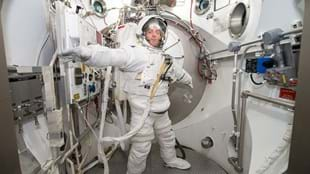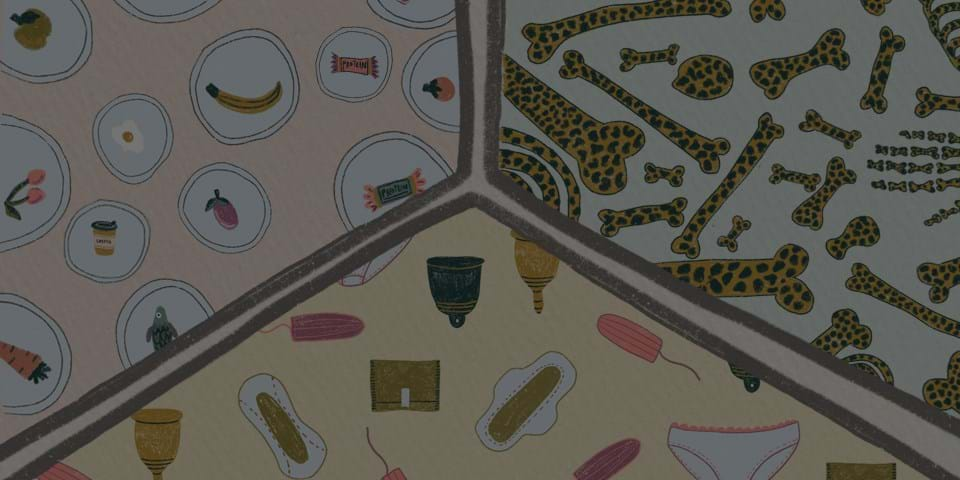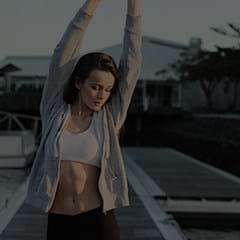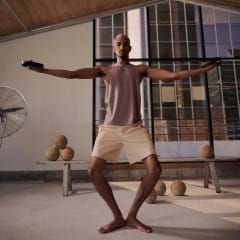Every day you go to work at NASA’s Johnson Space Center. You’re a Test Director, what does that mean?
Basically, my job is to try and break things others have designed by exposing them to the harsh thermal and vacuum environment of space. The aim is to make sure that whatever goes into space will survive. One of the main things that I work on is the spacesuit. As soon as an astronaut is assigned to a flight I work intensively with that crew member training them in spacesuit operations in one of our vacuum chambers. This is so that when they go to space they know how to use a spacesuit and what to do if something goes wrong – it’s just one of the ways we ensure astronauts are safe and successful in space so they can conduct the science.
When I’m not working at NASA I teach LES MILLS™ classes, and I have recently joined the Les Mills team as a trainer, helping train others to become BODYPUMP™ or BODYBALANCE™ instructors.
When I was little I always wanted to be an astronaut. I moved from Italy to the United States at age 19, studied Mechanical Engineering at college and then completed my Masters in Aerospace Engineering before landing a role at NASA. I actually did apply to the astronaut selection a couple of times and, despite not making it right through (every selection there are thousands who apply for just a handful of places1), it taught me a lot about how to be the best I can be. I love the fact that my current job requires me to take a lot of the classes that the astronauts take. For me to teach them how to use a spacesuit I need to know how to use a spacesuit. So I get to wear a spacesuit every so often – which really is my childhood dream come true!

Where did the interest in space and the human body come in?
During my Masters study I concentrated on human factors and space physiology. I learned a lot about the human body and how space travel and a lack of gravity affects things like bone loss, muscle loss, muscle atrophy. The effects can be significant. If someone is travelling to Mars, they might be in microgravity for nine months which means that the body can really deteriorate. We need to make sure this doesn’t happen which means constantly exploring the best ways to keep the calcium in the bones, and keep the muscles strong.
So how can it be done?
Astronauts can exercise, but there are challenges. Because you are in microgravity a barbell weighs nothing, so you could do a million bicep curls and there would be no benefit. This is where resistance bands come in. Astronauts are encouraged to do a lot of resistive exercises. We also have a treadmill on the space station, but the thing is you have to use bungy cords to anchor you down, otherwise you’ll just run off and float away!
Despite it not being part of your day-to-day job you’re extremely interested in the health specifics of space travel. How are you involved?
I am far from an expert but I’m very interested in human health and countermeasures for space travel which is why I’ve joined the human test subject facility – it’s a group of people that volunteer for experiments. Sometimes we are drafted to go fly on the zero-g plane, sometimes we just lie there while astronauts practice using ultrasounds and echocardiograms, and sometimes we provide our arm and veins so they can learn how to draw blood.
I was recently involved in a study designed to determine whether different exercise protocols can alleviate or prevent changes in vision and head pressure, this is important as astronauts can experience vision and pressure issues during space travel. Basically I wore an intraocular pressure measuring contact lens (that made me look like Borg from Star Trek) and did a series of leg presses while scientist measured all sorts of parameters.
I am fortunate to have a strong, healthy body, so I love having the opportunity to donate it to science while I am still alive. A lot of the research in space, especially in the field of human health, has direct repercussions to life on Earth so I want to help.

Of course it’s not only NASA’s astronauts that need to stay fit and healthy. Tell us about your involvement in the wellbeing of the wider NASA team.
We’re lucky to have a really nice recreational facility at NASA’s Johnson Space Center, it’s called Starport. Every Thursday lunchtime I teach a BODYPUMP class at Starport, and we’ve just introduced LES MILLS GRIT™ workouts on a Monday, Wednesday and Friday. For many of the NASA workforce it’s a great break in the day. A lot of us have pretty stressful jobs, so this lunchtime exercise is not only a way to keep us all healthy but also to de-stress.
Ninety nine per cent of people who attend are engineers, so it’s definitely not your typical group fitness class. I tell them about the science behind the workout, how the Rep Effect works and snippets from the latest Les Mills research – it always lands really well. I am all about research (obviously, given I am a nerd) and learning about the particular effects of different training techniques really keeps me motivated – and I use that to motivate others.
So what led a space engineer into group fitness instruction?
When the Starport team introduced BODYPUMP my wife dragged me along. I wasn’t terribly overweight or anything, but I just wasn’t particularly fit. BODYPUMP changed everything. I went to regular classes for 18 months and fell in love with it, then in 2011 I trained to become an instructor. It’s fortunate that my wife, who also works at NASA, is a fellow Les Mills instructor so group fitness is now ingrained in the fabric of our lives.
The role of space engineer and fitness instructor seem worlds apart. What are the challenges of juggling such diversity?
What I have found really interesting is that it’s actually a two way street. For me to successfully train astronauts I need to be able to deliver information clearly and succinctly so that it lands. And if you think about it, you need the same approach when you’re coaching a group fitness class. I love the idea of teaching in layers, throwing just enough information to ensure people understand, then adding a little more, and a little more.
I like that, like a lot of things that I do in my life, even though they are totally different, there is some convergence of some of the skills required.
On top of working full time at NASA, you have a busy role as a Les Mills trainer, a young family, and I understand you’re a qualified pilot and diver too. Where does your get up and go come from?
I just like to learn things, and keep bettering myself. I get bored being static. When something becomes second nature I am ready for the next thing. My day job is really conducive to that because I train an astronaut with a specific piece of hardware and then just as I am done, a new crew member comes along – it’s always changing. And I jump at the chance to embrace new opportunities. A good example of this is the work I have done with NASA TV, using my Italian to do real-time interpretation of any space-to-ground press conferences featuring Italian astronauts. A highlight was when I got to interpret a press conference featuring Pope Benedict XVI!
When it comes to fitness my two year old son keeps me motivated. I was never particularly fit until I discovered BODYPUMP and now I can’t help but notice how many of my generation would benefit from a healthier lifestyle. I look at my son, and other kids in his generation, and I don’t want them to have the same health problems that my generation is experiencing. This motivates me to be the best I can be, to make my generation not only healthier but to teach our children to be healthier when they grow up.

So how do you motivate others?
Convincing my NASA co-workers to get involved with lunchtime exercise hasn’t been hard. I am around them every day and they’ve seen how it has helped transform me – they’ve seen the tangible results that come from dedicating a small pocket of time to something as important of your health.
Now that I am involved in training aspiring instructors I often reflect on what has kept me going over the years. My favorite piece of advice goes with any aspect of life; don’t worry so much about the outcome as you will miss everything along the journey. Just focus on being your best and don’t forget to look around you and seek the opportunities, because if you’re just so stuck on the final goal, chances are that you’re not going to get there and you’re going to miss all the lessons along the way.
If you want more health and fitness inspiration simply sign up to Fit Planet and get the freshest insights and advice straight to your inbox.







